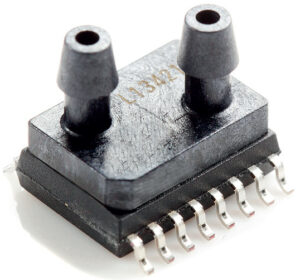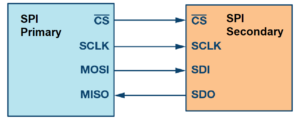Get an understanding of how to select sensors and microcontrollers for your IoT product, with an emphasis on circuit design to optimize performance.
Sensors in IoT devices collect data from the environment, after which the data can be processed and analyzed to make intelligent decisions. The quality of your sensors and how well you integrate them into the overall architecture play an important role in an IoT system’s effectiveness.
The IoT sensor landscape
IoT systems employ a wide array of sensors, each serving a specific purpose. These include:
- Motion sensors for detecting movement and orientation.
- Visual sensors such as cameras and other imaging devices (Figure 1).
- Temperature sensors that monitor the environment (Figure 2).
- Pressure sensors that monitor fluid and gas pressure (Figure 3).
- Speed sensors that track velocity in automotive and industrial applications.

Each sensor type plays a unique role in IoT applications. For instance, motion sensors are crucial in-home security systems, while temperature sensors are indispensable in smart HVAC systems and industrial process monitoring. The key is to understand the specific needs of your IoT applications and choose sensors that align with those requirements.
Criteria for sensor selection
Selecting the right sensor for an IoT application is a multi-faceted decision. For starters, the sensor must be compatible with a device’s hardware and software architecture. Such compatibility includes voltage levels, communication protocols, and physical dimensions. For battery-operated or remote IoT devices, energy efficiency is a critical factor. Sensors with low-power modes and quick wake-up times are often preferred.

A sensor’s accuracy and resolution can significantly impact the quality of collected data. High-precision sensors are essential for applications where small measurement errors can lead to significant consequences, such as in medical devices.
The three factors — compatibility, energy efficiency, and precision — are interlinked. A sensor may be highly accurate but consumes too much power, making it unsuitable for battery-operated devices. Similarly, a low-power sensor may lack the precision needed for certain applications. Therefore, a balanced approach is essential in sensor selection, keeping in mind the specific requirements of the IoT device’s intended application.
Circuit design for sensor integration
Integrating multiple sensors into a single IoT device is not a straightforward task.

Microstructures SM9543 differential pressure sensor.
Challenges include:
- Power management: Different sensors may have varying voltage and current requirements, necessitating complex power-management architectures.
- Data collision: With multiple sensors transmitting data simultaneously, there’s a risk of data collision, leading to loss of information.
- Circuit complexity: More sensors mean more components, such as resistors, capacitors, and multiplexers, which increase circuit complexity.
To overcome these challenges, you can employ several techniques, such as:
- Multiplexing: This allows multiple sensors to share a single communication line, reducing the number of GPIO pins.
- Efficient power management circuits: Using voltage regulators and power-gating techniques can help manage the power requirements of different sensors.
- Modular design: Designing the circuit in a modular fashion can simplify the integration process, making it easier to add or remove sensors.
- Energy-harvesting circuits: These circuits can generate power from environmental sources such as light or heat, reducing dependency on batteries.
- Error-correction algorithms: These algorithms can detect and correct errors during data transmission, ensuring data integrity.
- Universal sensor interfaces: These are standardized interfaces that simplify the process of integrating different types of sensors.
The integration of sensors into IoT devices is a complex but crucial aspect that demands meticulous attention to circuit design. From power management to data collision prevention, the challenges are numerous but not insurmountable.
As we transition from circuit design to communication protocols, it’s essential to understand that choosing the communication methods for sensor networks will further influence the design and functionality of the IoT device.
Communication protocols
Communication protocols such as I2C, SPI, and UART are commonly used in sensor networks. Each has its advantages and disadvantages.

I2C (Figure 4) is simple to use but may be slow and lack robustness in noisy environments. SPI (Figure 5) is faster and more robust but requires more pins for communication. UART, on the other hand, is easy to implement but lacks the advanced features of I2C and SPI.
The choice of communication protocol is another pivotal decision in IoT device design. For instance, SPI’s requirement for more pins than I2C might necessitate a larger PCB or more complex signal routing. I2C’s susceptibility to noise might require additional filtering components to mitigate noise.

Whether it’s I2C’s simplicity, SPI’s speed, or UART’s ease of implementation, each protocol has its own set of advantages and disadvantages that can significantly impact circuit design and overall device performance. The effectiveness of sensor interaction is highly dependent on the reliability and speed of the chosen communication protocols.
Sensors and connected workers
Once a system collects data, that data can go to a central processing unit (CPU), microcontroller, or computer at a network edge or in the cloud for further analysis. This data can provide insight for numerous applications, including real-time monitoring, predictive maintenance, and even automated decision-making.
Data quality is paramount. Poorly calibrated sensors or noisy environments can lead to inaccurate data, which can result in incorrect analyses and actions. Therefore, from a circuit design perspective, it’s crucial to integrate features such as noise filtering and data-validation circuits to ensure data integrity.
In mission-critical applications such as healthcare monitoring systems or industrial automation, real-time communication is not just a luxury but a necessity. Any delay in data transmission can have severe consequences, including system failures or even life-threatening situations.
To ensure real-time communication, the circuit design must incorporate high-speed data pathways and possibly dedicated communication lines for critical sensors. Additionally, the use of real-time operating systems (RTOS) can help manage the timing and priority of data packets, ensuring that the device transmits crucial information on time.
Sensors and connected workers are intricately intertwined and linked in the IoT ecosystem. The effectiveness of this relationship hinges on the quality of data collected and the speed and reliability of its transmission. As we transition to the topic of data processing and analysis, you must recognize that the ultimate utility of sensor data lies in how effectively it can be processed and interpreted.
Data processing and analysis
The next step involves processing and analysis, a stage where embedded systems and microcontrollers are crucial. These components serve as the central processing units for the entire data-management workflow, handling tasks that range from simple data filtering and analog-to-digital conversion to intricate algorithmic analyses.
Data processing speed is critical, especially in applications requiring real-time decision-making. Slow or inefficient processing can lead to delays, which are unacceptable in mission-critical applications. Therefore, you must carefully choose a microcontroller and design the embedded system for optimal for speed and efficiency.
With the advent of edge computing and machine learning algorithms, IoT devices are becoming increasingly capable of advanced data analysis. These techniques allow for more sophisticated decision-making, such as predictive maintenance in industrial applications or early disease detection in healthcare systems.
From a circuit design perspective, integrating advanced algorithms may require specialized hardware such as graphics processing units (GPUs) or tensor-processing units (TPUs). These components can accelerate data processing but also add complexity and power requirements to the circuit design.
Data processing and analysis are the final steps in the sensor data pipeline, turning raw data into actionable insights. The choice of embedded systems and the integration of advanced data analysis techniques can significantly impact the effectiveness of an IoT device.
Future trends in sensor integration
The landscape of sensor integration in IoT devices is ever evolving, driven by advancements in technology and a growing understanding of the potential applications of IoT systems. As we look to the future, several trends are emerging that promise to redefine how sensors are selected, integrated, and utilized.
- AI-driven sensor networks: Artificial intelligence (AI) is making its way into sensor networks, enabling more intelligent decision-making. These AI-driven networks can analyze data in real-time and make autonomous decisions, reducing the need for human intervention.
- Quantum sensors: Quantum technology promises to bring a new level of precision and sensitivity to sensors. Quantum sensors could revolutionize fields such as healthcare, where ultra-precise measurements are often required.
- Flexible and wearable sensors: With advancements in materials science, we are seeing the development of flexible and wearable sensors. These sensors can be integrated into clothing or directly onto the skin, opening new possibilities for health monitoring and human-machine interaction.
- Energy-efficient designs: As the world becomes increasingly conscious of energy consumption, energy-efficient sensor designs are becoming more critical. These designs not only extend battery life but also reduce the overall environmental impact of IoT devices.
Some other future developments on the horizon — and some of them even closer — include edge computing for localized data processing, reducing latency and bandwidth usage, and integrated, built-in security features in sensors, which will become increasingly important to protect data integrity.
The future of sensor integration is not just about the sensors themselves but also about the circuit designs that accommodate them. Advanced materials such as graphene, new fabrication techniques such as 3D printing, and innovative circuit architectures could revolutionize how sensors are integrated into IoT devices. These advancements will enable more efficient, reliable, and versatile devices capable of supporting the emerging technologies listed above.
As we venture into the future, the trends in sensor integration point towards more intelligent, efficient, and versatile IoT devices. The role of circuit design in enabling these advancements cannot be overstated, and professionals in the circuit design industry can contribute to the development of next-generation IoT devices that are not just innovative but also practical and sustainable.
Conclusion
The world of IoT is complex and ever-changing, but one thing remains constant: the need for effective sensor selection and integration. By understanding the challenges and opportunities that lie ahead, we can pave the way for more innovative, efficient, and effective IoT devices.
About the Author
Eric Whitley is the Director of Smart Manufacturing at L2L. He helps clients learn and implement the company’s pragmatic and simple approach to corporate digital transformation. Previously, he led the Total Productive Maintenance effort at Autoliv ASP and has served in Management Certification programs at The Ohio State University, where he was an adjunct faculty member.
Related articles:
